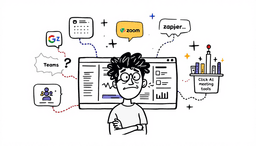Speaker identification is the process of figuring out who is speaking in an Audio recording. AI meeting tools that turn recordings into structured transcripts and short summaries need this feature because it lets systems link statements to the right person and preserve the conversation's context. The need for reliable speaker-aware summarization has grown a lot as remote and hybrid work has become more common.

Speaker Identification Technology Overview
Speaker identification uses machine learning, pattern matching, and the extraction of acoustic features. Systems first convert Audio into features (pitch, timbre, spectral patterns) that capture both physiological and behavioral voice traits. These features feed models, often deep neural networks or probabilistic classifiers, that learn to separate and label speakers across a recording. Speaker diarization (segmenting Audio by speaker turns) and speaker recognition (matching segments to known identities) are two everyday tasks. Large, diverse training datasets and iterative algorithm tuning improve robustness and reduce false matches.

Importance and Applications
Why it matters: speaker-aware summaries make things clear, hold people accountable, and enable action. When comments are correctly attributed, teams can keep track of who said what, assign follow-ups, and make sure decisions are made. In real life, AI summarization tools use speaker identification to:
- Tag speakers in transcripts so that readers can see who made each point.
- Create summaries for each speaker that highlight their action items and points of view.
- Allow users to search by speaker to find all a person's comments across all their meetings.
The best platforms include these features in their meeting workflows. They show transcripts with speaker labels, time-stamped highlights, and summaries for each speaker, which are used in task lists and CRM entries.
Best AI Tools for Speaker Identification
Several AI tools stand out for their speaker identification capabilities, each tailored to different team sizes and use cases. Here's a comparison of top performers:
| Tool | Rating | Key Features | Accuracy |
| Sembly | Excellent | ✓ Voice fingerprinting ✓ Real-time ID ✓ Speaker analytics ✓ Custom profiles | 98% |
| Fireflies | Excellent | ✓ Talk time analysis ✓ Sentiment tracking ✓ Interruption insights | 95% |
| Gong | Excellent | ✓ Customer vs rep tracking ✓ Talk ratio ✓ Objection detection | 96% |
| Otter.ai | Very Good | ✓ Easy labeling ✓ Voice training ✓ Quick corrections ✓ Highlights | 90% |
These tools integrate speaker identification into their core workflows, offering features like real-time diarization, speaker-specific analytics, and custom voice profiles. Whether you're managing a large enterprise meeting or a small team huddle, choosing the right tool can dramatically improve the quality and usability of your meeting summaries.
Challenges and Considerations
Audio from the real world is messy. Accents, overlapping speech, background noise, and other similar vocal traits can make things less accurate. Segmentation is more complex when the recordings are short and of poor quality, and supervised training is limited by privacy or a lack of labeled data. To fix these problems, teams should focus on getting high-quality Audio, use a variety of training datasets, and use noise-robust preprocessing. Transparent model evaluation and human review loops also help keep trust and accuracy.
Future of Speaker Identification
Expect speaker ID to work better with other AI features, such as context-aware summarization that accounts for speakers' roles, emotion-aware tagging, and real-time captions that identify who is speaking during live calls. Better self-supervised learning and bigger, more varied voice datasets will make it easier to understand accents and different settings. These changes, along with privacy-preserving techniques, will make speaker-aware meeting tools both more useful and more respectful of user data.
Conclusion
Speaker identification turns unorganized Audio into useful information that can be traced back to the person who said it. This makes meetings more productive and helps people follow through on their commitments. AI summarization tools can deliver clearer transcripts, speaker-specific summaries, and searchable records by leveraging robust Audio processing, machine learning, and careful data handling. Check out the speaker-aware features on SummarizeMeeting.com to see how they can help you run your meetings more smoothly.


